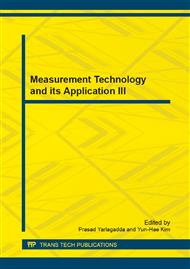[1]
A. Novoselac, J. Srebric, A critical review on the performance and design of combined ceiling and displacement ventilation systems, Energy and Buildings 34 (5) (2002) 497–509.
DOI: 10.1016/s0378-7788(01)00134-7
Google Scholar
[2]
S.G. Hodder, D.L. Loveday, K.C. Parsons, A.H. Taki, Thermal comfort in chilled ceiling and displacement ventilation environments: vertical radiant temperature asymmetry effects, Energy and Buildings 27 (2) (1998) 167–173.
DOI: 10.1016/s0378-7788(97)00038-8
Google Scholar
[3]
T. Imanari, T. Omori, K. Bogaki, Thermal comfort and energy consumption of the radiant ceiling panel system. Comparison with the conventional all-air system, Energy and Buildings 30 (2) (1999) 167–175.
DOI: 10.1016/s0378-7788(98)00084-x
Google Scholar
[4]
H. Feustel, C. Ctetiu, Hydronic radiant cooling-preliminary assessment, Energy and Buildings 22 (3) (1995) 193–205.
DOI: 10.1016/0378-7788(95)00922-k
Google Scholar
[5]
J. Niu, J.V.D. Kooi, H.V.D. Ree, Energy saving possibility with cooled-ceiling systems, Energy and Buildings 23 (2) (1995) 147–158.
DOI: 10.1016/0378-7788(95)00937-x
Google Scholar
[6]
B. Costelloe, D. Finn, Indirect evaporative cooling potential in air-water systems in temperate climates, Energy and Buildings 35 (5) (2003) 573–591.
DOI: 10.1016/s0378-7788(02)00161-5
Google Scholar
[7]
G. Gan, S.B. Riffat, Numerical simulation of closed wet cooling towers for chilled systems, Applied Thermal Engineering 19 (12) (1999) 1279–1296.
DOI: 10.1016/s1359-4311(99)00002-2
Google Scholar
[8]
J. Faca˜o, A.C. Oliveira, Thermal behavior of closed wet cooling towers for use with chilled ceilings, Applied Thermal Engineering 20 (2000) 1225–1236.
DOI: 10.1016/s1359-4311(99)00096-4
Google Scholar
[9]
P. Vangtook, S. Chirarattananon, Application of radiant cooling as a passive cooling option in hot humid climate, Building and Environment 42 (2) (2007) 543–556.
DOI: 10.1016/j.buildenv.2005.09.014
Google Scholar
[10]
Y. Yamagishi, T. Sugeno, T. Ishige, An evaluation of microencapsulated PCM for use in cold energy transportation medium, in: Proceedings of IECEC, Washington, DC, USA, (1996), p.2077–(2083).
DOI: 10.1109/iecec.1996.553442
Google Scholar
[11]
Y. Yamagishi, H. Takeuchi, A.T. Pyatenko, Characteristics of microencapsulated PCM slurry as heat-transfer fluid, AIChE Journal 45 (4) (1999) 696–707.
DOI: 10.1002/aic.690450405
Google Scholar
[12]
X. Wang, J. Niu, Y. Li, X. Wang, B. Chen, R. Zeng, Q. Song, Y. Zhang, Flow and heat transfer behaviors of phase change material slurries in a horizontal circular tube, International Journal of Heat and Mass Transfer 50 (13) (2007) 2480–2491.
DOI: 10.1016/j.ijheatmasstransfer.2006.12.024
Google Scholar


